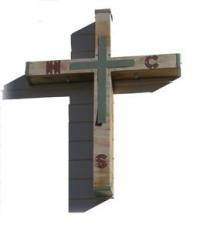Home-Holy Cross reflections in Miramar
- Introduction
- Research process
- Learning outcomes
- Our History
- Catherine McAuley, founder of the Mercy Sisters
- Marcellin Champagnat
- Sister Natalie, Mercy Sister
- Brother Doug, Marist Brother
- A past student - Pauline
- Our Principal's story
- Special Character
- Feast of the Holy Cross
- Meditation and what it means to us
- Sister Ema and meditation
- Lights, camera, meditation
- Sign of the Cross
- The Holy Cross Parish
- About Miramar
- Ngake and Whataitai
- The First State House In New Zealand
- The Miramar Cutting
- Our team
- References and acknowledgements
Sign of the Cross
Since we make the Sign of the Cross before and after our prayers, many Catholics don't realise that the Sign of the Cross is a prayer itself. It should be said with reverence, we shouldn't rush through it on the way to the next prayer.
The cross in this image was made by Joseph Graham in his final year at Holy Cross School. It has been mounted on the outside wall of Room 8. Joseph completed this cross as part of his home-learning, CHOICE challenge.
How to make the sign of the cross: Using your right hand, you should touch your forehead at the mention of the Father; the lower middle of your chest at the mention of the Son; and the left shoulder on the word "Holy" and the right shoulder on the word "Spirit."
| The Sign of the Cross in English and Pacifika Languages "In the name of the Father, and of the Son, and of the Holy Spirit. Amen."
The Sign of the Cross is a symbolic ritual gesture which marks the four points of the Cross on Calvary over one's body. It also represents loving God with all one's heart, soul, mind and strength.
In the name of the Father, and of the Son and
Ki te ingoa o te Matua, o te Tamaiti o te
I le suafa o le Tama, ma le Alo, ma le Agaga
I he huafa o e Tamai, mo e Alo, mo e
I te igoa o te Tamana, te Ataliki, ma te |
By Luka & Lui, Year 6

